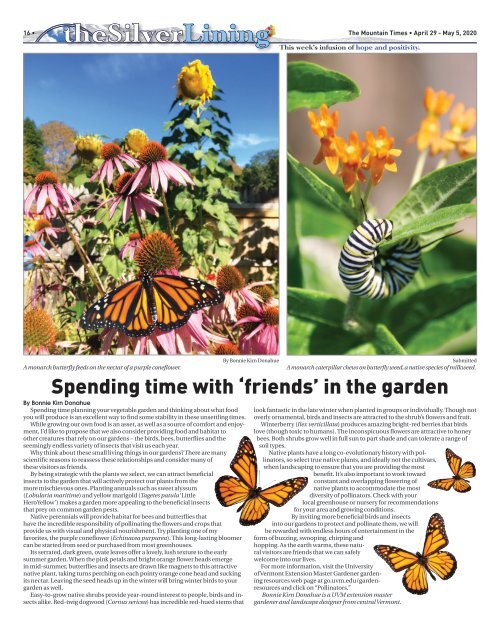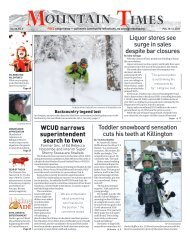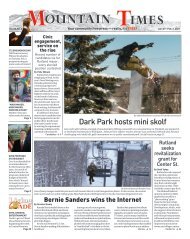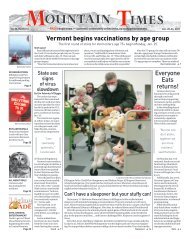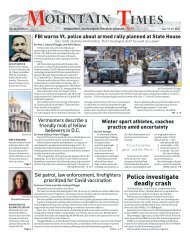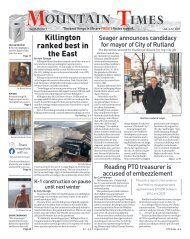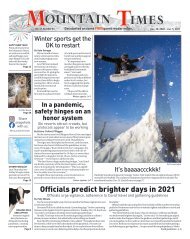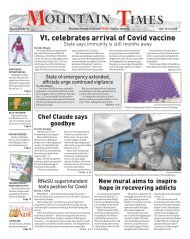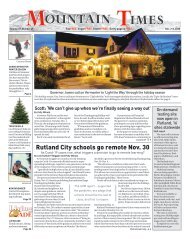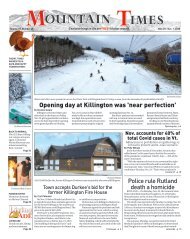Mountain Times- Volume 49, Number 18 - April 29 - May 5, 2020
You also want an ePaper? Increase the reach of your titles
YUMPU automatically turns print PDFs into web optimized ePapers that Google loves.
theSilverLining<br />
16 • The <strong>Mountain</strong> <strong>Times</strong> • <strong>April</strong> <strong>29</strong> - <strong>May</strong> 5, <strong>2020</strong><br />
This week’s infusion of hope and positivity.<br />
A monarch butterfly feeds on the nectar of a purple coneflower.<br />
Spending time with ‘friends’ in the garden<br />
By Bonnie Kirn Donahue<br />
Spending time planning your vegetable garden and thinking about what food<br />
you will produce is an excellent way to find some stability in these unsettling times.<br />
While growing our own food is an asset, as well as a source of comfort and enjoyment,<br />
I’d like to propose that we also consider providing food and habitat to<br />
other creatures that rely on our gardens – the birds, bees, butterflies and the<br />
seemingly endless variety of insects that visit us each year.<br />
Why think about these small living things in our gardens? There are many<br />
scientific reasons to reassess these relationships and consider many of<br />
these visitors as friends.<br />
By being strategic with the plants we select, we can attract beneficial<br />
insects to the garden that will actively protect our plants from the<br />
more mischievous ones. Planting annuals such as sweet alyssum<br />
(Lobularia maritime) and yellow marigold (Tagetes patula ‘Little<br />
HeroYellow’) makes a garden more appealing to the beneficial insects<br />
that prey on common garden pests.<br />
Native perennials will provide habitat for bees and butterflies that<br />
have the incredible responsibility of pollinating the flowers and crops that<br />
provide us with visual and physical nourishment. Try planting one of my<br />
favorites, the purple coneflower (Echinacea purpurea). This long-lasting bloomer<br />
can be started from seed or purchased from most greenhouses.<br />
Its serrated, dark green, ovate leaves offer a lovely, lush texture to the early<br />
summer garden. When the pink petals and bright orange flower heads emerge<br />
in mid-summer, butterflies and insects are drawn like magnets to this attractive<br />
native plant, taking turns perching on each pointy orange cone head and sucking<br />
its nectar. Leaving the seed heads up in the winter will bring winter birds to your<br />
garden as well.<br />
Easy-to-grow native shrubs provide year-round interest to people, birds and insects<br />
alike. Red-twig dogwood (Cornus sericea) has incredible red-hued stems that<br />
By Bonnie Kirn Donahue<br />
Submitted<br />
A monarch caterpillar chews on butterfly weed, a native species of milkweed.<br />
look fantastic in the late winter when planted in groups or individually. Though not<br />
overly ornamental, birds and insects are attracted to the shrub’s flowers and fruit.<br />
Winterberry (Ilex verticillata) produces amazing bright-red berries that birds<br />
love (though toxic to humans). The inconspicuous flowers are attractive to honey<br />
bees. Both shrubs grow well in full sun to part shade and can tolerate a range of<br />
soil types.<br />
Native plants have a long co-evolutionary history with pollinators,<br />
so select true native plants, and ideally not the cultivars,<br />
when landscaping to ensure that you are providing the most<br />
benefit. It’s also important to work toward<br />
constant and overlapping flowering of<br />
native plants to accommodate the most<br />
diversity of pollinators. Check with your<br />
local greenhouse or nursery for recommendations<br />
for your area and growing conditions.<br />
By inviting more beneficial birds and insects<br />
into our gardens to protect and pollinate them, we will<br />
be rewarded with endless hours of entertainment in the<br />
form of buzzing, swooping, chirping and<br />
hopping. As the earth warms, these natural<br />
visitors are friends that we can safely<br />
welcome into our lives.<br />
For more information, visit the University<br />
of Vermont Extension Master Gardener gardening<br />
resources web page at go.uvm.edu/gardenresources<br />
and click on “Pollinators.”<br />
Bonnie Kirn Donahue is a UVM extension master<br />
gardener and landscape designer from central Vermont.


